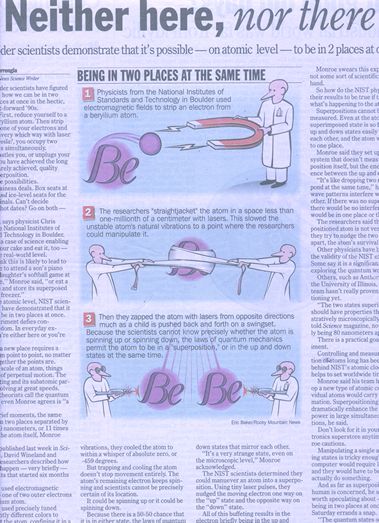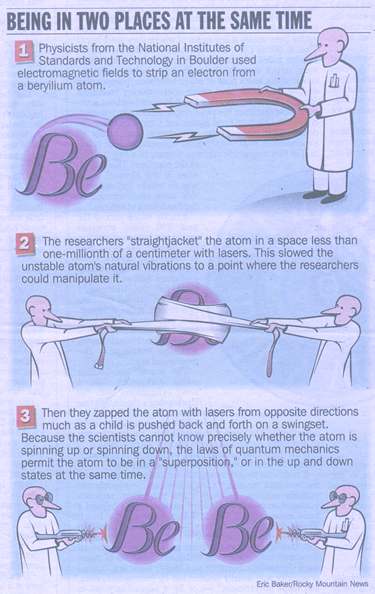Origin
Of Be Be's Name
The tale
of My name
is best told when you've settled comfortably
in your favorite chair with all your favorite acoutrements.
Tea, crumpets, coffee, scones, bowl, soda etc.
Then I would begin by saying,
"Well... that's the name on my birth certificate,"
or I could tell you to view it as a chosen phenomena.
Either way... science seems to have found a way to describe my "self"
in as much as the word applies to the object or subject
as reflective of the word itself.
Therefore, Be is my first name, and Be is my last name.
It's who I am and it's what I do best and,
my name reflects my attitude toward my identity.
In my search for meaning in this
land of the children of the woods,
I have discovered myself.
The who I think I am and the who I think I want to be
who the "I Am" is
in relationship to the me I think I am.
To the "divine" observer
whom is myself.
Zounds... Dr. Seuess! I think you've outdone it!
Anyway,
I cut the following article from the Rocky Mountain News
because I liked what it said
and want to share with you what it says regarding "My" name.
First I will show you the Full
Size article as it appeared
in the Rocky Mountain News, Sunday, June 9, 1996. Page 51A
Then I will display the text of
the article,
and then tell you my comments of the article and how it affects me.
Credits: Science Section Editor
Mike Anton, 303-892-2327
or e-mail science@denver-rmn.com.
The following article "Neither Here, nor there"
by Joseph B. Verrengia, Rocky Mountain News Science Writer.


Boulder scientists have figured
out
how we can be in two places at once in the hectic, fast-forward '90s.
First, reduce yourself to a beryllium
atom.
Then strip off one of your electrons and zap yourself every which way
with laser beams until voila!, you occupy two physical
states simultaneously.
If nobody jostles you, or unplugs your equipment,
you have achieved the long sought,
but rarely achieved,
quality known as superposition.
Think of the possibilities.
Dueling business deals.
Box seats at the Rockies and ice-level seats for the Stanley Cup finals,
at the same time.
Can't decide between two hot dates? Go on both -- then choose.
"Not so fast,"
says physicist Chris Monroe of the National Institute
of Standards and Technology in Boulder.
This is not a case of science
enabling you to have your cake and eat it, too
-- at least on the real-world level.
"I don't think this likely
to lead to our being able to attend a son's piano recital
and a daughter's softball game at the same time,"
Monroe said,
"or eat a birthday cake and store its superposed double in the
freezer."
Still, on the atomic level, NIST
scientists say
they have demonstrated that it is possible to be in two places at once.
Their experiment defies conventional
wisdom.
In everyday experience, you're either here or you're there.
Moving to a new place requires
a transition
from point to point no matter now close together the points are.
But on the scale of an atom, things
are in a state of perpetual motion.
The atom is vibrating and its subatomic particles are revolving at great
speeds.
This is what theorists call the quantum world,
which even Monroe agrees is "a weird place."
For very brief moments,
the same atom can be in two places separated by as much as 80 nanometers,
or 11 times the width of the atom itself, Monroe said.
In a paper published last week
in Science,
Monroe, David Wineland and other NIST researchers described
how they made it happen -- very briefly -- in experiments that started
six months ago.
First, they used electromagnetic
fields
to strip one of two outer electrons from a beryllium atom.
Next, they used precisely tuned
lasers of slightly different colors
to straightjacket the atom,
confining it in a trap less than 1-millionth of a centimeter across.
By preventing its natural vibrations,
they cooled the atom to within a whisper of absolute zero, or -459 degrees.
But trapping and cooling the atom
doesn't stop movement entirely.
The atom's remaining electron keeps spinning
and scientists cannot be precisely certain of its location.
It could be spinning up or spinning
down.
Because there is a 50-50 chance
that it is in either state,
the laws of quantum mechanics allow for the electron to be placed in
a "superposition"
-- in up and down states that mirror each other.
"It's a very strange state,
even on the microscopic level, "Monroe acknowledged.
The NIST scientists determined
they could manuever an atom into a superpostion.
Using tiny laser pulses,
they nudged the moving electron one way on the "up" state
and the opposite way on the "down" state.
"All of this buffeting results
in the electron briefly being
in the up and down states at the same time,
or superpositioned," Monroe said.
Monroe swears this experiment
is not some sort of scientific sleight of hand.
So how do the NIST physicists
know their results to be true
if they can't see what's happening to the atom?
Superpositions cannot be directly
measured.
Even at the atomic level, the superimposed state is so fragile
that the up and down states easily collapse into each other,
and the atom would return to one place.
Monroe said they set up a detection
system that doesn't measure the superimposition itself,
but the energy interference between the up and down states.
"It's like dropping two rocks
in a pond at the same time," he said.
"The wave patterns interfere with each other.
If there was no superposition, there would be no interference.
It would be in one place or the other."
The researchers said the superpositioned
atom is not very durable.
As they try to nudge the two states farther apart, the atom's survival
rate sinks.
Other physicists have been debating
the validity of the NIST experiment.
Some say it is a significant step in exploring the quantum world.
Others, such as Anthony Leggett
of the University of Illinois,
say the NIST team hasn't really proven superpositioning yet.
"The two states superimposed
should have properties
that are demonstratively microscopically disctinct,"
he told Science magazine, not just physically
being 80 nanometers apart."
There is a practical goal to the
experiment.
Controlling and measuring the
vibration of atoms
long has been the key behind NIST's atomic clock,
which helps to set worldwide time.
Monroe said his team hopes to
develop a new type of atomic computer.
"Individual atoms would carry bits of information.
Superpositioning would dramatically enhance the computing power
in large simultaneous applications," he said.
"Don't look for it in your
nearest electronics superstore anytime soon," Monroe cautions.
Manipulating a single atom into
dueling states is tricky enough.
An atomic computer would required lots of atoms,
and they would have to be harnessed to actually so something.
And as far as superpositioning
a human is concerned ,
he said it's not worth speculating about --
even if being in two places at once would make Saturday errands a snap.
"The quantum state of things,
like birthday cakes
and people are just too complicated," Monroe said.
Now... if you are willing to explore quantum physics even further...
watch the movie
"What the Bleep Do We Know!"
And
"The Secret"


![[Click to Return HOME]](Images/HomeButton.jpg)